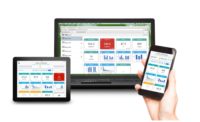By Eric Garr, Regional Sales Manager, Fortress Technology
For several years AI and Industry 4.0 has been the subject of hype, with the race to shorten production times, reduce costs and improve quality a continual focus. Following a year of pandemic disruption, today North American food factories are seeking practical technologies rather than unattainable solutions. As they set out on a new path, they want machines that can propel them forward, facilitate smarter decision making and increase efficiency. Step forward food safety specialist Fortress Technology.
With robust communication the starting point of any good digital transformation program, Fortress recently launched its new suite of connectivity software. Adding to the existing turnkey packages like Contact Reporter - included as standard on all Stealth and Interceptor metal detector models - plus optional Contact Manager to facilitate the collection of data over a network, Fortress unveils the addition of communication adapters and Contact 4.0. Giving food factories complete choice in data retrieval technologies to support their Industry 4.0 journey. New options include OPC/UA and Ethernet/IP communication to facilitate real-time end-to-end production visibility and enhanced maintenance, Quality Assurance and due diligence.
“Connectivity is key,” emphasizes Eric. “We are entering a new Internet of Things (IoT) era where everything that can be connected will be connected. Knitting together the extraction of data and bridging the gap between machines and humans to help predict rather than react to all types of production scenarios.”
Manually monitoring food inspection machine performance can be extremely labor intensive and impact productivity. Even those that have upgraded legacy systems continue to gather data on a machine-by-machine basis rather than integrating and analyzing information side-by-side and building up a performance picture, suggests Eric.
For many manufacturing IT departments, selecting which Internet of Things (IoT) technology will add the greatest value can be deemed a minefield and create a sense of burden. There’s a misperception that moving towards Industry 4.0 will require extensive investment, a dedicated team of developers and slow or limited return on investment.
Eric expands, “Although many of Fortress customers express a strong interest in innovation and harnessing the power of data capture, some have been reticent to take the leap of faith. There is an underlying belief that they will not be able to connect new applications with existing legacy inspection machines. Humans can often get overwhelmed when there are too many options. As a result, data integration projects can stretch on for months, years, or never reach a decision. In such a fast moving sector like food manufacturing, this has an immense impact on competitiveness.”
Dynamic data for everyone
To assist customers gather real time data, Fortress digital conveyor, gravity, pipeline and combination metal detectors are equipped with optional machine sensors to run signals between everything from reject confirmation, to bin doors, air pressure, infeed and encoders and more. Deploying more sensors naturally generates more intelligent machine, fault and process data. All of this data can be viewed in Contact Reporter. Resulting in a more failsafe and smarter inspection system, notes Eric. Contact 4.0 provides further features, including gathering data generated by multiple networked metal detectors within a fleet and automatically sending email alerts when faults occur to production managers.
For any food plant making tentative steps into digital decision making, Contact Reporter provides a robust, easy to use event logging and record keeping solution available as standard on Stealth and Interceptor metal detectors. No complex integration is required. Users simply install Contact Reporter onto their business PC.
Time-stamped data is extracted via USB on a machine-by-machine basis. When uploaded onto the PC, Contact Reporter software converts this data into readable formats detailing contaminant events ranging from rejects to machine setting changes and test results. “This automated record keeping of all events and performance verifications is essential for quality control and ultimately audits. Additionally, data generated can highlight to production managers bottlenecks and drill down to the machine’s performance flagging potential upstream processing issues,” notes Eric.
Rather than manually collecting and transferring data, Stealth and Interceptor users can opt for automated data extraction. Through an in-built Ethernet port, Contact Manager does the legwork polling the metal detectors over a network connection. This can lead to more consistent reporting and a more accurate data picture for each metal detector, as well as future proofing Smart Factory automation projects.
Both Contact Reporter and Contact Manager maintain compliance with all international food safety standards, including HACCP, BRC and GFSI/SQF. “For food SMEs in particular, Fortress recognizes that digital fear remains prevalent. Contact provides a transition step from manual, hard copy data gathering to a digitized Food Quality Management system and begins to facilitate data use in a more sophisticated way,” states Eric.
Highlighting that it’s never too soon to set the wheels in motion, Eric advises organizations of all sizes, but especially SMEs, to begin exploring established automation platforms to optimize productivity.
Small data tipping point
The main goal of Industry 4.0 is improving system connectivity to support better decision making. It enables seamless communications to and from higher level business systems for a fully integrated production. Experts already predict that 2021 will be the year when small data supersedes big data[i].
In food inspection, the quantity of data tags is fairly small. Yet, this makes it easier to automate the identification of meaningful patterns. When time-series granular data is monitored side by side across a fleet of machines 24/7, it provides production managers with the level of production oversight previously unattainable.
Responding to this trend, Fortress is gearing up to launch Contact 4.0. A web-based remote management solution, it enables multi-site food plants to review and collect data and securely monitor the performance of their metal detectors and checkweighers connected on the same network.
Providing secure access via a web gateway, authorized users simply log into the browser from a computer, tablet or smart phone. By creating this cohesive reporting system, production and QA managers can troubleshoot a performance issue without having to be physically in front of the metal detector. The fully traceable and time stamped data details what and when an event occurred on a specific unit.
Smarter machine monitoring
Despite fears of cybersecurity breaches, paper records actually bring higher risks than digital data. Not only can manually collated information be incorrectly recorded, forgotten or lost, results can also be deliberately falsified. If producers cannot prove when and where inspection of their products took place, food manufacturers may then be unable to demonstrate HACCP compliance and could be forced to re-inspect an entire batch. This not only slows down production, at worst it could trigger a product recall.
Utilizing automated data integration technologies like OPC/UA Adapter and Ethernet/IP Adapter provides a robust, simpler and safer way to rapidly stream data within the firewall of a business network. Data tags defined by each food factory are converted in real time to an internal business database. Again, providing valuable oversight to support flexible production.
Fortress Technology’s OPC/UA Adapter is a one way solution, collecting data and storing defined data and production parameters. Its interoperability allows multiple metal detectors to feed data in real time into a client’s central server. Additionally, the OPC/UA architecture is supported by most major automation technology suppliers. Making it easier to synchronize data generated by multiple machines in smart processing environments.
Remote reality
Paving the way for remote management of multiple machines across multiple sites within local IT infrastructures, both Fortress’ Adapter solutions and Contact 4.0 give food manufacturers the technology to connect and view the performance of an unlimited number of metal detectors.
During the COVID-19 pandemic, remote assistance was a service in high demand. The ability to fix an issue without incurring an engineer site visit saves money and reduces machine downtime.
Eric summarizes, “With our communication adapters, comparable performance data can provide production decision makers with a benchmark to drive efficiency improvements. Taking this to the next level, predictive models may then be applied in order to anticipate equipment failure and enable predictive maintenance.”
The road ahead
As more and more of the equipment in food factories become connected, increasing volumes of data will afford operators and suppliers ever greater control, improving efficiency, ensuring food safety and providing full traceability.
Latency, fragmentation and security are critical areas that continue to be addressed as the race towards Industry 4.0 accelerates. Eric is quick to point out that connectivity is the foundation of any good digitization strategy commenting, “The standout factor that makes data so valuable is how it is analyzed, spots trends and patterns and as a result informs better business decisions.”
Reassuringly for Fortress customers, implementation of all Contact software is quick and doesn’t divert a company’s in-house IT resources away from other projects. Functional and available on all Stealth and Interceptor metal detectors, it’s simple to adapt using Fortress Technology’s new suite of Industry 4.0 tools. Delivering practical data integration in the format to match every customer’s internal reporting systems.
For more information visit www.fortresstechnology.com.
[i] https://hbr.org/2020/02/small-data-can-play-a-big-role-in-ai



Report Abusive Comment